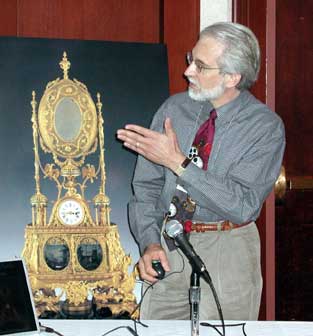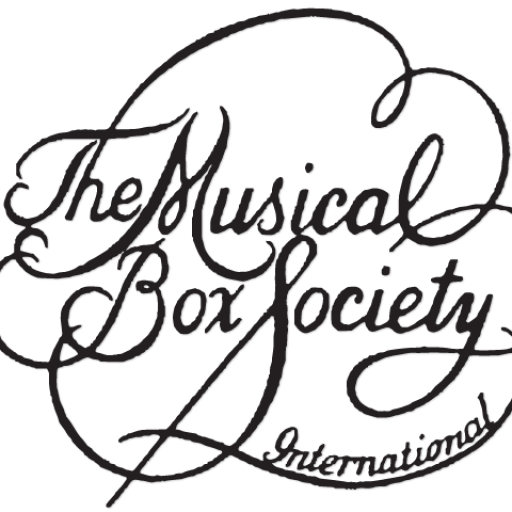How a music box works – basics
MBSI News
Speaker’s Bureau
 Do you belong to a club, school, church, or library which would enjoy seeing, hearing, and learning about mechanical musical instruments? We may have a member in your area that would be happy to share his knowledge with you. Call 610 459-0367, and we will do our best to have an MBSI member address your group.
Do you belong to a club, school, church, or library which would enjoy seeing, hearing, and learning about mechanical musical instruments? We may have a member in your area that would be happy to share his knowledge with you. Call 610 459-0367, and we will do our best to have an MBSI member address your group.
Repairing Automatic Musical Instruments
We are often asked about repairing music boxes and pneumatic instruments. The cost to do so will vary, depending upon the condition of the item, and that cost may exceed the box’s value in the case of modern music boxes. However, when a strong emotional connection exists, repair cost may be a minor consideration. More elaborate pneumatic instruments or antique music boxes are almost always worth repairing, unless damage to them is extremely severe.
Most musical movements can be repaired, especially if the musical comb is intact. A competent repair specialist can substitute parts or make new ones, if original spare parts are unavailable. If the musical movement is beyond salvage, it can be replaced with a new movement from one of the modern manufacturers, often with a tune of the owner’s choosing.
If an antique music box has suffered a run (when the governor controlling the unwinding of the spring motor disengages, allowing the cylinder to spin rapidly and violently), as evidenced by broken comb teeth or bent cylinder pins, this damage can be repaired by tooth replacement (or, if luck is with you, a substitute comb) and pin straightening by a skilled technician.
If your instrument needs repair or servicing, please consult the MBSI web site links page to find a qualified technician as near to you as possible. Some specialize in the repair of certain types of instruments, such as cylinder or disc music boxes, bird boxes and whistlers, mechanical organs, and automata. Our links page also lists dealers who buy and sell instruments as well as people who repair and restore almost the entire range of automatic musical instruments.
If there is no service technician conveniently near to you, it may be wiser to ship the instrument to one more distant than to entrust it to a person not accustomed to working with these rather specialized machines. In cases where you feel the need of a consultation but find no one nearby to consult, we may be able, by the use of our Member Directory, to refer you to a collector in your area who has experience in the care and operation of your type of instrument and whose advice may help you to find the best technician for your needs.
Tune Availability
Some people have a favorite tune that they would like to have their musical instrument or box play. In the case of a pneumatic roll-playing instrument, this is generally feasible, because there are arrangers and roll makers for instruments, large and small, who can produce an arrangement of the tune of your choice. However, in the case of cylinder music boxes this is more difficult.
Both Reuge, the sole surviving Swiss music box maker of the many that existed in the 1800’s and 1900’s, and Sankyo, a Japanese manufacturer, maintain an inventory of stock tunes on pinned cylinders, from the smallest 18-note novelty movement size to more musical 50-note movements. Sankyo’s tune list is believed to be more extensive than Reuge. But even still, considering the millions of tunes that have been composed over the centuries, your chances of finding in stock the one particular tune of your heart’s desire are slim indeed.
Reuge will custom pin cylinders with the tune of a customer’s choice, assuming the tune is suitable for arranging for a limited musical scale and for a playing time of short duration. Arranging costs are significant, and Reuge requires a minimum order for custom work. These factors price the work beyond the average person’s budget.
An alternative worth exploring is a little 20-note, hand-cranked musical movement played by a punched paper strip. It is made by Sankyo and is available for around $60 from at least one MBSI member/dealer. It comes with five pre-punched strips, two blank strips, a hole punch, and instructions on arranging your own tunes for it to play.
What is not a music box?
Just as installing a CD system in your automobile does not change its essential nature as a car, installing a small novelty-type musical movement in a cigar box does not make your cigar box a music box.
The MBSI is not able to tell you much about any collectible item into which the item’s manufacturer has installed a small musical movement obtained from one of several makers. The place to go for information on those collectibles — be they furniture, ceramic items, stuffed toys, jewelry boxes, or whatever — is the group, magazine, or collectors’ club which is interested in the item used to house the musical movement.
There are exceptions to this rule. Musical Christmas tree stands is one such exception as are Lador powder boxes and musical photo albums. Boxes and watches sold under the Reuge name are usually worth repairing as are those made by Sankyo. There are a few others but by and large, when the significance of the musical aspect is far outweighed by the importance of its housing, the object in question falls outside the focus of the MBSI.
